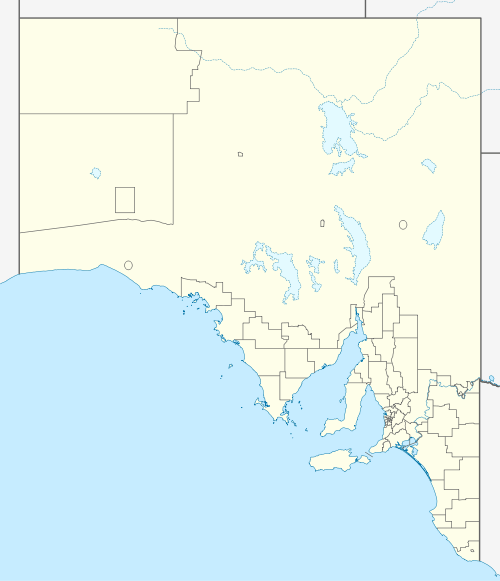Swan Reach, South Australia
Swan Reach is a river port in South Australia 127 km north-east of Adelaide on the Murray River between Blanchetown and Mannum in South Australia. It is on the left (or east) bank of the river. The Swan Reach Ferry is a cable ferry crossing operated by the state government as part of the state's road network. Swan Reach, with all parts below Lock #1, is also one of the lowest parts of the river. It is currently (2009–2010) about 1.5 metres below its normal level. At the 2016 census, Swan Reach had a population of 283.[1]
| Swan Reach South Australia | |
|---|---|
 Swan Reach | |
| Coordinates | 34°34′04″S 139°35′59″E |
| Population | 283 (2016 census)[1] |
| Postcode(s) | 5354 |
| Time zone | ACST (UTC+9:30) |
| • Summer (DST) | ACDT (UTC+10:30) |
| LGA(s) | Mid Murray Council |
| State electorate(s) | Chaffey |
| Federal Division(s) | Barker |
History
Swan Reach was first settled in the 1850s and was originally the largest of five sheep and cattle stations in the area. It soon became one of the first riverboat ports in South Australia and was a loading port for grain and wool.
Around the town
Swan Reach has an area school, hotel and bottle shop, general store and post office, an op shop that opens Mondays to Fridays and Saturday mornings, and a fast food take-away shop near the ferry. The tourist boat Proud Mary and paddle-wheeler PS Murray Princess stop at the town once a week. There is a Lutheran church, with regular services, and a Lutheran pastor in residence. Anglican and Roman Catholic services are held monthly. Tourism, agriculture and irrigated horticulture are the main industries, and there is a large almond processing plant 1.5 km from town on the Stott Highway.
River Murray International Dark Sky Reserve
The Swan Reach Conservation Park lies in a 3,200-square-kilometre (1,200 sq mi)[2] area which was named the nation's first, and the world's 15th[3] International Dark sky reserve in October 2019, by the International Dark-Sky Association.[2] The "dark sky" title refers to areas where the night sky has a high darkness rating and there are policy controls to ensure light pollution is kept to a minimum, with reserve status only given when both public and private residential land is included.[3]
A multi-million-dollar joint project between Silentium Defence and the Western Sydney University to build an observatory to monitor satellites and other objects orbiting the earth was announced in June 2020. The Murray Mallee location and terrain of the land was considered ideal for the purpose.[4]
The reserve's official name is the River Murray International Dark Sky Reserve.[2][5]
Notes and references
- Australian Bureau of Statistics (27 June 2017). "Swan Reach (L) (Urban Centre/Locality)". 2016 Census QuickStats. Retrieved 29 October 2011.

- "About Us". River Murray Dark Sky Reserve. Retrieved 1 July 2020.
- Collins, Laura; Butcher, Anita; Dawes, Samantha (7 November 2019). "River Murray International Dark Sky Reserve, our first official reserve, lands Australia's darkest sky status". ABC News. Australian Broadcasting Corporation. Retrieved 23 June 2020.
- Vonic-Joyce, Meg; Step, Matt (23 June 2020). "SA's River Murray Dark Sky Reserve to become home of space traffic management facility". ABC News. Australian Broadcasting Corporation. Retrieved 23 June 2020.
- "The International Dark-Sky Association (IDA)". International Dark-Sky Association. 7 November 2019. Retrieved 1 July 2020.
External links
- Township of Swan Reach South Australia - swanreach.sa.au
- Swan Reach Area School
- Swan Reach Lutheran Parish